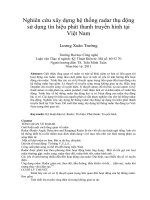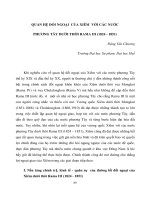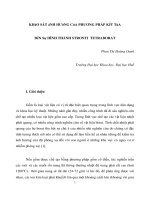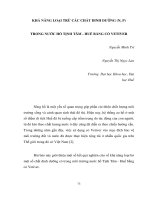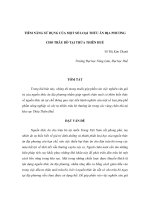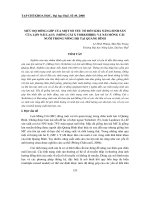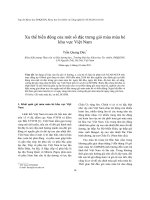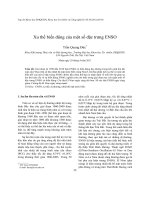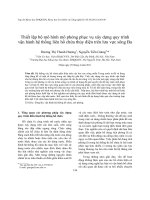Báo cáo nghiên cứu khoa học: "YẾU TỐ QUYẾT ĐỊNH CỦA CHẤT LƯỢNG DỊCH VỤ BÁN LẺ - SIÊU THỊ TẠI VIỆT NAM" ppt
Bạn đang xem bản rút gọn của tài liệu. Xem và tải ngay bản đầy đủ của tài liệu tại đây (327.04 KB, 9 trang )
TẠP CHÍ PHÁT TRIỂN KH&CN, TẬP 10, SỐ 08 - 2007
Trang 15
DETERMINANTS OF RETAIL SERVICE QUALITY - A STUDY OF
SUPERMARKETS IN VIETNAM
Nguyen Dang Duy Nhat
(1)
, Le Nguyen Hau
(2)
(1) Maastricht School of Management - Vietnam Program
(2) University of Technology, VNU-HCM
ABSTRACT: This study aims at identifying components of retail service quality in
Vietnamese Supermarkets. A survey of 440 shoppers in various supermarkets in HCMC has
resulted that service quality of supermarket composes of 4 factors namely Service Personnel,
Physical Aspects, Policy and Reliability. Among which, Service personnel has the strongest
impact and Physical Aspects has the weakest one, while the role of Reliability is not confirmed
by the data. From these findings, managerial as well as theoretical implications have been
discussed.
Keywords: Service Quality, Retail Service Quality Scale, Supermarket, Vietnam
.
1. INTRODUCTION
Service quality has drawn attention of researchers and managers in recent decades
(Zeithaml, 2000). It has become a significant subject because of its impact on customer
satisfaction. By satisfying customers through high quality service, business firms not only
retain their current customers, but also increase their market share (Finn and Lamb, 1991). To
date, many studies on service quality relied on service quality construct and scale by
Parasuraman et al. (1988). However, this application to the retail industry may not be
appropriate for service quality in retailing industry seems to be different from other services
(Kaul, 2005; Dabholka et al, 1996). In retail setting, especially retail stores where there is a
mix of product and service, retailers are likely to have impact on service quality more than on
product quality (Dabholkar et al., 1996). As retailers can create such effects, service quality
plays a significant strategic role in creating quality perceptions.
With the rapid development of modern retailers in Vietnam in terms of number of stores
and value, understanding of retail service quality and identifying determinants of retail service
quality has become strategic importance for retailers or the so-called supermarkets in Vietnam.
However, there have been very few studies on retail service quality in supermarkets in Vietnam
(Nguyen, 2006). The current study is aimed to explore the components of retail service quality in
the case of supermarkets in Vietnam by borrowing a framework developed by Dabholkar et al.
(1996). It also investigates the relationships between each of retail service quality components and
customers’ overall evaluation of retail service quality in Vietnamese supermarkets.
The paper is organized as follows. After this introduction, a review of literature on service
quality is presented, which is followed by a proposed model and hypotheses. Next section
describes the research design and data collection process. Then, the results of data analysis are
presented and discussed. Managerial implications are also highlighted.
2. LITERATURE REVIEW
2.1. Service Quality
Service quality is a critical component of customer perceptions about the service.
Customers perceive services in terms of its quality and how satisfied they are overall with their
experiences (Zeithaml, 2000). As thus, service quality is defined as customers’ perception of
Science & Technology Development, Vol 10, No.08 - 2007
Trang 16
how well a service meets or exceeds their expectations (Czepiel, 1990). In the retail context,
perceptions of service encounters accumulate over time and a customer’s relationship with an
organization are a continuation of exchanges or interactions both past and present” (Czepiel,
1990). When customers evaluate retail service, they compare their perceptions of the service
they receive with their expectations. Customers are satisfied when the perceived service meets
or exceeds their expectations. They’re dissatisfied when they feel the service falls below their
expectations (Levy and Weitz, 2005).
2.2. Review of Service Quality Models
As service industry has contributed significantly to global economy in the past few
decades, service quality also draws attention of many practitioners and researchers. There were
various service quality models proposed and applied in different contexts. For the purpose of
this study, concepts and literatures related 3 models are presented: SERVQUAL and GAP
model by Parasuraman et al. (1988), SERVPERF by Cronin and Taylor (1992), Retail Service
Quality Model by Dabholkar et al. (1996).
Servqual and Gap Model: In 1980s, in the attempt to define service quality and develop a
model of service quality, Parasuraman et al. conducted an exploratory investigation. The
results showed that regardless of the type of service, consumers used basically the similar
criteria in evaluating service quality (Parasuraman et al., 1985). They labeled those 10 criteria
“service quality determinants”. Since then, service quality was defined through 10 dimensions:
access, communication, competence, courtesy, credibility, reliability, responsiveness, security,
tangibles and understanding/knowing the customer. Later, they were simplified into five
dimensions including tangibles, reliability, responsiveness, assurance and empathy. This
model indicates that consumer perceptions of quality are influenced by five gaps occurring in
the internal process of service delivery. The basic premise is that service quality can be
defined by the difference between expected service and perceived service (Parasuraman et al,
1985). The first four are those on the service provider side of service. Gap 5 is related to the
customer side of service. These gaps are (1) the difference between what customers expected
and what management perceived customer expected; (2) the difference between management’s
perceptions of customer expectations and the translation of those perceptions into service
quality specifications; (3) the difference between actual service quality specifications and the
delivery of those specifications to customer service actually delivered; (4) the difference
between the services delivered to customers and the external communications about the
service; and (5) the difference between customer expectations and perceptions. Although
SERVQUAL has been applied in the study of different types of service industries, there are
certain limitations and criticisms. Some of the widespread concerns are the 5 dimension
configuration of the scale, the appropriateness of operationalizing service quality as the
expectations-performances gap score, and the scale’s applicability to a retail setting (Bakakus
and Boller, 1992; Finn and Lamb, 1991; Reeves and Bednar 1994).
Servperf: With an argument that Parasurman et al.’s gap theory of service quality was
supported by little empirical or theoretical evidence, Cronin and Taylor (1992) developed a
"performance-based" service quality measurement scale called SERVPERF. The major difference
between these two scales is that SERVQUAL operationalises service quality by comparing the
perceptions of the service received with expectations, while SERVPERF maintains only the
perceptions of service quality. The SERVPERF scale consists of 22 perception items excluding any
consideration of expectations. The superiority of SERVPERF over SERVQUAL has been
demonstrated in numerous studies including those by Avkiran (1999), Lee et al. (2000) and Brady
et al. (2002). However, the continued use of and reference to SERVQUAL in marketing literature
TẠP CHÍ PHÁT TRIỂN KH&CN, TẬP 10, SỐ 08 - 2007
Trang 17
suggest that “consensus has not yet been reached relative to the superiority of performance-only
measures of service quality” (Brady et al. 2002, p. 18).
Retail Service Quality Scale (RSQS): To contextually fit the retail industry, Dabholkar et
al. (1996) developed Retail Service Quality Model (RSQS). Based on SERVPERF, RSQS
includes 28-item scale, of which 17 items are from SERVPERF and 11 items are developed by
qualitative research. It composes of 5 dimensions, namely (1) Physical aspects – Retail store
appearance and store layout; (2) Reliability – Retailers keep their promises and do the right
things; (3) Personal interaction – Retail store personnel are courteous, helpful, and inspire
confidence in customers; (4) Problem solving – Retail store personnel are capable to handle
returns and exchanges, customers’ problems and complaints; and (5) Policy – Retail store’s
policy on merchandise quality, parking, operation hours, and credit cards.
RSQS has been used by some researchers in measuring service quality in certain types of
retailers such as department stores, supermarkets and discount stores in Western and Eastern
countries. Kim et al. (2001) conducted a study with U.S. and Korean customers of discount
stores. The findings showed that customers' perceptions of service quality do not view service
quality in as similar manner, nor do U.S. and Korean customers of discount stores. In other
words, the dimensionality of service quality is not universal across industries or across
countries (Kim et al, 2001). Mehta et al (2000) conducted a research on service quality in the
contexts of supermarkets and electronic good retailers in Singapore. The results showed that
“RSQS was superior within the context of more good and less service environment, i.e. a
supermarket, while SERVPERF was better for a retailing context where the service element
becomes more important, i.e. an electronic goods retailer.” (Mehta et al, 2000). Moreover,
Kaul (2003) found that RSQS dimensions were not valid in India. In Vietnam, Nguyen (2006)
tested a model on the relationships between service quality, customer satisfaction and loyalty
in supermarkets in HCMC and found that retail service quality composes of 5 dimensions:
goods assortment, personnel, appearance, physical aspects and safety. This study
recommended that SERQUAL and RSQS could be applied in Vietnam provided that they are
adjusted to the specific context of study.
3. MODEL & HYPOTHESES
Figure 1. Model of retail service quality in Supermarket in Vietnam
Overall Evaluation of
Retail Service Quality
Polic
y
Problem Solvin
g
Personal Interaction
Reliability
Physical Aspects
H1
(
+
)
H2
(
+
)
H3
(
+
)
H4
(
+
)
H5
(
+
)
Science & Technology Development, Vol 10, No.08 - 2007
Trang 18
Based on the above review, RSQS is employed in this empirical study of service quality in
Vietnamese supermarkets. However, to be independent from the result of Nguyen (2006), this
study adopts the original model of Dabholkar et al. (1996). The model (Figure 1) proposed a
structure for retail service quality consisting of five dimensions: Physical aspects, Reliability,
Personal interaction, Problem solving and Policy. In this study, five dimensions of service
quality are tested with the overall evaluation of shoppers on the service quality.
Physical aspects: Physical aspects of retailer include equipment and fixtures, physical
facilities, materials associated with this supermarket’s service, convenience of physical
facilities and layouts. This dimension has broader meaning than does the SERVQUAL’s
tangible dimension. In addition to the appearance of the facilities, it also takes into account the
convenience offered the customer by the layout of physical facilities. The higher customers
appreciate on the physical aspects, the higher the overall evaluation of retail service quality is.
H1: There is a positive impact of physical aspects on overall evaluation of retail service quality.
Reliability: The construct reliability here is similar to SERVQUAL reliability dimension.
Reliability of retailers includes keeping promises to do something, providing right service,
available merchandise and error-free sales transactions and records. The higher customers
appreciate on reliability, the higher the overall evaluation of retail service quality is.
H2: There is a positive impact of reliability on overall evaluation of retail service quality.
Personal Interaction: The personal interaction dimension of retailers includes employees
having knowledge to answer questions, inspiring confidence, providing prompt service,
willing to respond to customer’s requests, giving customers individual attention, showing
consistent courteousy with customers and even treat customers properly on the phone. The
higher customers appreciate personal interaction, the higher the overall evaluation of retail
service quality is.
H3: There is a positive impact of personal interaction on overall evaluation of retail service quality.
Problem solving: Problem solving addresses handling of returns, exchanges and
complaints. The problem solving dimension of retailers includes: willingness of retailers to
handle returns and exchanges, sincere interest in problem and handling customer complaints
directly and immediately. The higher customers appreciate problem solving, the higher overall
evaluation of retail service quality is.
H4: There is a positive impact of problem solving on overall evaluation of retail service quality.
Policy: This dimension captures aspects of service quality that are directly influenced by
retailers’ policy. It includes high quality merchandise, convenience of parking and operating
hours as well as accepting major credit cards. The higher customers appreciate policy, the
higher the overall evaluation of retail service quality is.
H5: Policy has positive impact on overall evaluation of retail service quality.
4. RESEARCH METHOD
Data were collected via a large sample survey. Based on a qualitative exploratory study using
in depth interviews, 28 items of RSQS were examined and/or revised. The questionnaire was then
finalized to conduct official quantitative research. Respondents of the survey were Vietnamese
shoppers. A convenient sampling was used at 4 biggest supermarkets in HCM city. By this process,
440 usable questionnaires were received. In terms of measurement scale, RSQS of supermarkets in
Vietnam was measured using RSQS (Dabholkar et al., 1996) which was in the form of 5-point
Likert scale. However, some items were not relevant to the supermarket setting in Vietnam. For
example, service quality via telephone or credit cards. Other questions which were not easy to
TẠP CHÍ PHÁT TRIỂN KH&CN, TẬP 10, SỐ 08 - 2007
Trang 19
understand after qualitative research and pre-testing were revised accordingly. The scale for overall
evaluation of service quality was adjusted from Fornell et al. (1996).
5. RESULTS AND DISCUSSION
Collected data were analyzed using SPSS software package. EFA was first applied to each
of the 5 constructs to assess unidimensionality (Conway and Huffcutt, 2003). Next, reliability
was assessed for each scale. Then, a joint EFA was applied to all scales together to
preliminarily assess convergent validity and discriminant validity (Hair et al., 1998). Multiple
regression was lastly employed to test the model.
The results show that 7 variables were eliminated due to low factor loadings or cross-factor
loading. The 18 remaining items were grouped into 4 factors (Table 1). Personal interaction
(PIN) and Problem solving (PRO) were converged into one factor termed “Service personnel”.
Consequently, retail service quality in this study composes 4 components namely Service
personnel, physical aspect, policy, and reliability. The indicators of each component are
illustrated in Table 1. Statistics also indicate that 3 items in the scale for overall evaluation of
service quality are qualified with loadings from 0.784 to 0.894; Eigenvalue 1.906; Cronbach
alpha 0.712. The initial model was adjusted to account for the 4 components of service quality,
instead of 5 components. The qualified items were then used to calculate the score for each
construct in the adjusted model by averaging the scores of items included in each construct.
Correlation coefficients between the dependent variable and independent variables range
from 0.247 to 0.511 which indicate significant linear associations between them. Multiple
regression resulted in an adjusted R
2
= 0.361, meaning that 36.1% variance of the dependent
variable can be explained by four mentioned antecedents. The results also indicate that Service
personnel (beta = 0.291), Physical aspect (beta = 0.212) and Policy (beta = 0.251) significantly
contribute (p < 0.05) to explain the overall evaluation of service quality, while beta value for
Reliability is as low as 0.024 which is non-significant. VIF values score from 1.180 to 1.514
indicating that multicollinearity among independent variables is not a problem.
The results provide statistical evidence to support hypotheses on the significantly positive
impact of Service personnel, Physical aspect and Policy on the overall evaluation of service
quality. On the other hand, the hypothesis on the positive impact of reliability on the overall
evaluation of service quality was not supported by the empirical data in this study.
The results of this study evoke some discussion. Firstly, in this empirical study, the scales
for Personal Interaction and Problem Solving don’t meet discriminant validity because they
are loading on the same factor. These two dimensions include items, which are related to
services provided by supermarket’s employees; therefore to go further in this research this
factor is termed “Service personnel”. Although, not being congruent to the original scale by
Dabholkar et al. (1996) in the US, this result is quite consistent with the results of Mehta et al
(2000) in Singapore and Nguyen (2006) in Vietnam, in which all items related to personnel
(interaction and problem solving) are converged into only one component.
Secondly, the RSQS scale applied to Vietnam has been refined to four-component
construct which consists of 18 items representing Service Personnel, Physical Aspects, Policy
and Reliability. Among these components, three factors Service Personnel, Physical Aspects
and Policy significantly impact on the overall retail service quality of supermarkets in
Vietnam. The results also show that Service Personnel has the highest impact and Physical
Aspects has the lowest one, while the role of Reliability does not confirmed by the data.
Science & Technology Development, Vol 10, No.08 - 2007
Trang 20
Table 1. EFA results of retail service quality measurement scale
Factor
Variables Code
1 2 3 4
+ Individual attention
+ Never too busy to respond to customer’s
request
+ Handling complaints directly and immediately
+ Willingness to handle returns and exchanges
+ Sincere interest to solve problem
+ Consistently courteous with customers
+ Behavior of employees instills confidence in
customers
+ Giving prompt service
+ Telling exactly what will be performed
+ Employees’ knowledge to answer questions
+ Modern-looking equipment & fixtures
+ Clean, attractive, convenient physical
facilities
+ Attractive store and physical facilities
+ Appealing materials associated
+ Convenient operating hours
+ Convenient parking lot
+ Providing services at the time promising to
do
+ Promising to do something and doing so
PIN18
PIN17
PRO22
PRO20
PRO21
PIN19
PIN13
PIN15
PIN16
PIN12
PAA01
PAA04
PAA02
PAA03
POL25
POL24
REL08
REL07
0.713
0.674
0.672
0.667
0.652
0.645
0.571
0.522
0.451
0.449
0.649
0.612
0.519
0.499
0.737
0.683
0.718
0.469
Eigenvalue
5.88 1.46 1.18 1.04
Variance extracted %
32.65 8.11 6.54 5.77
Cronbach’s Alpha
0.86 0.66 0.66 0.55
6. CONCLUSION
Managerial implications: This study has demonstrated the actual measurement of retail
service quality in Vietnamese supermarkets and considered the impact of retail service quality
on customer’s overall evaluation of retail service quality. In this respect, this paper suggests
certain managerial implications for supermarkets and their managers in Vietnam.
Firstly, Service Personnel is the key factor impacting customer’s perception of service
quality in supermarkets. By improving the performance of employees, supermarkets can
increase customer’s satisfaction. In addition, other factors that customers are concerned at
supermarkets are Policy and Physical Aspects. Existing supermarkets and new/ potential
entrants to Vietnam must specify the weight of each factor impacting customer’s perception of
service quality. Based on these weights and the average score for each factor, supermarkets
can propose appropriate action plans.
Secondly, international retailers especially supermarkets which are about to come to do
business in Vietnam should be attentive when studying on retail service quality in Vietnam so
that they can focus on major dimensions and plan to meet the customers’ expectations. Other
factors impacting customer’s overall evaluation of retail service quality should be taken into
account in future research.
TẠP CHÍ PHÁT TRIỂN KH&CN, TẬP 10, SỐ 08 - 2007
Trang 21
Theoretical implications: The results of this study provide additional empirical evidence
to evaluate the RSQS when being employed in the case of supermarkets. The original five
dimensions of RSQS does not factor out in this study as they did not factor out in the previous
research in the case of supermarkets (e.g. Mehta et al, 2000; Kim and Jin, 2001; Kaul, 2005).
This indication is somehow similar to Kaul’s comment when employing the RSQS to study
about retail service quality in Indian supermarket setting in 2005. That is, retailers and
researchers who apply the RSQS to retailers or supermarkets in general or in Vietnam in
particular should pay attention and need to adapt the measurement scale.
Limitations and further research directions: First, this study was only conducted in
supermarkets in HCMC. Generalizability will definitely be improved if other cities were
included. Second, the results of this study may further be validated by employing CFA and
Structural Equation Modeling. Third, the four factors of retail service quality can explain
36.1% of the variance of customer’s overall evaluation of retail service quality. Other
uncovered factors may exist. Future research should consider factors such as merchandise,
display, safety, promotion policy, loyalty policy, etc. Lastly, future research should take into
account of other types of retailers in Vietnam.
CÁC YẾU TỐ ẢNH HƯỞNG ĐẾN CHẤT LƯỢNG DỊCH VỤ BÁN LẺ -
NGHIÊN CỨU Ở CÁC SIÊU THỊ TP.HCM
Nguyễn Đăng Duy Nhất
(1)
, Lê Nguyễn Hậu
(2)
(1) Maastricht School of Management - Vietnam Program
(2) Trường Đại học Bách khoa, ĐHQG-HCM
TÓM TẮT: Bài báo này nhằm nhận dạng các thành phần của chất lượng dịch vụ trong
các Siêu thị ở VN. Kết quả khảo sát 440 khách hàng ở các siêu thị ở Tp.HCM cho thấy chất
lượng dịch vụ ở siêu thị gồm 4 thành phần: Nhân viên phục vụ, Trưng bày siêu thị, Chính sách
phục vụ và Độ tin cậy. Trong đó, Nhân viên phục vụ có ảnh hưởng mạnh nhất và Trưng bày
siêu thị có ảnh hưởng yếu nhất, trong khi Chính sách phục vụ ảnh hưởng không đáng kể đến
chất lượng dịch vụ siêu thị. Qua đó, ý nghĩa về mặt lý thuyết và ứng dụng được đề cập.
REFERENCES
[1]. Avkiran, N.K, Quality customer service demands human contact, International
Journal of Bank Marketing, 17, 2, pp. 61–71, (1999).
[2]. Babakus, E. & Boller, W.G., A Empirical Assessment of the SERVQUAL Scale,
Journal of Business Research, 24, 253-268, (1992)
[3]. Brady, M.K., Cronin, J.J. & Brand, R. R., Performance-only measures of service
quality: a replication and extension, Journal of Business Research, 55, pp. 17–31,
(2002).
[4]. Broderick, A.J. and Vachirapornpuk, S, Service quality in internet banking: the
importance of customer role, Marketing Intelligence and Planning, Vol. 20 No. 6, pp.
327-35, (2002).
Science & Technology Development, Vol 10, No.08 - 2007
Trang 22
[5]. Conway and Huffcutt, A Review and Evaluation of Exploratory Factor Analysis
Practices in Organizational Research, Organizational Research Methods, Vol. 6, No.
2, 147-168, (2003).
[6]. Cronin Jr. J J and Taylor, S A, Servperf versus Servqual: Reconciling Performance-
based and Perceptions-Minus-Expectations Measurement of Service Quality, Journal
of Marketing, 58(1), 125-131, (1994).
[7]. Cronin, Jr. J J and Taylor, S A, Measuring Service Quality: A Reexamination and
Extension, Journal of Marketing, 55(3), 55-68, (1992).
[8]. CzepieI, J A, Service encounters and service relationships: implications for research'
Journal of Business Research 20, 13-21, (1990).
[9]. Dabholkar, P.; Thorpe, D. and Rentz, J. A Measure of Service Quality for Retail
Stores: Scale Development and Validation, Journal of the Academy of Marketing
Science, 24 (Winter), 3-16, (1996).
[10]. Finn, D.W. and Lamb, C.W., An evaluation of the SERVQUAL scale in a retailing
setting, in Holman, R. and Solomon, M.R. (Eds), Advances in Consumer Research,
Association for Consumer Research, Provo, UT, pp. 483-90, (1991).
[11]. Fornell, C., Johnson, M.D., Anderson, E.W., Cha, J., and Bryant, B.E., The American
Customer Satisfaction Index: Nature, purpose, & findings, Journal of Marketing
(60:4) pp7-18, (1996).
[12]. Frost, F.A. and Kumar, M, Intservqual: internal adaptation of the GAP model in a
large service organization, Journal of Services Marketing, Vol. 14 No. 5, pp. 358-77,
(2000).
[13]. Hair, J.F., Anderson, R.E., Tatham, R.L. and Black, W.C. Multivariate Data
Analysis, 5
th
edition. Prentice-Hall. New Jersey, (1998).
[14]. Kaul, Subhashini, Measuring retail service quality: Examining applicability of
international research perspectives in India, IIMA Working Papers, (2005).
[15]. Kim, S. & Byoungho, J, Validating the retail service quality scale for US & Korean
customers of discount stores: an exploratory study, Journal of Services Marketing,
7(2), 223-237, (2002).
[16]. Levy and Weitz, Retailing Management, the 6
th
Edition, McGraw-Hill, (2005).
[17]. Mehta, Subhash C., Ashok Lalwani and Soon Li Han (2000). Service quality in
retailing: relative efficiency of alternative measurement scales for different product-
service environments, International Journal of Retail & Distribution Management, 28
(2), 62-72.
[18]. Nguyen, Thi Mai Trang, Service Quality, Customer Satisfaction and Loyalty: A study
of supermarkets in Ho Chi Minh City, Journal of Science and Technology
Development – Social Sciences Humanitites and Management, Vol. 9 No 10, pp.57-
70, (2006).
[19]. Parasuraman A. and Leonard L. Berry, Marketing Services: Competing through
Quality, New York: Free Press, (1990).
[20]. Parasuraman, A., Zeithaml, V.A. and Berry, L.L., A conceptual model of service
quality and its implications for future research, Journal of Marketing, Vol. 49 No. 3,
pp. 41-50, (1985).
[21]. Parasuraman, A., Zeithaml, V.A. and Berry, L.L., Servqual: A multiple item scale for
measuring consumer perceptions of service quality, Journal of Retailing, Vol. 64
(Spring 1988), pp. 12 – 40, (1988).
TẠP CHÍ PHÁT TRIỂN KH&CN, TẬP 10, SỐ 08 - 2007
Trang 23
[22]. Parasuraman, Leonard L. Berry, and Valarie A. Zeithaml, An Empirical Examination
of Relationships in an Extended Service Quality Model., Marketing Science Institute
Working Paper Series, Report No. 90-122 (Cambridge, MA: Marketing Science
Institute), (1990).
[23]. Reeves and Bednar, Defining quality: Alternatives and implications, Academy of
Management Review, 19, 419 – 445, (1994).
[24]. Santos, J., E-service quality: a model of virtual service quality dimensions, Managing
Service Quality, Vol.13 No. 3, pp. 233-46, (2003).
[25]. Seth N., SG Deshmukh, Prem Vrat, Service Quality Models: A Review, The
International Journal of Quality & Reliability Management, 22, 8/9, 913-949, (2005).
[26]. Soteriou, C. & Stavrinides, Y., An internal customer service quality data envelope
analysis model for bank branches, International Journal of Bank Marketing, Vol. 18
No.5, pp. 246-52, (2000).
[27]. Sweeney, J.C., Soutar, G.N., and Johnson, L.W, Retail service quality and perceived
value, Journal of Retailing and Consumer Services, Vol.4, No.1, 39-48, (1997).
[28]. Sweeney, J.C., Soutar, G.N., and Johnson, L.W, The Role of Perceived Risk in the
Quality-Value Relationship: A Study in a Retail Environment, Journal of Retailing,
77-105, (1999).
[29]. Zeithaml, V.A., A. Parasuraman, and Leonard L. Berry, Delivering Quality Service:
Balancing Customer Perceptions and Expectations, New York: Free Press, (1990).
[30]. Zeithaml, V.A., Parasuraman, A., and Malhotra, A., A Conceptual Framework for
Understanding Eservice Quality: Implications for Future Research and Managerial
Practice, Working Paper No. 00-115, Marketing Science Institute, Cambridge, MA,
(2000).
[31]. Zhu, F.X., Wymer, W.J. and Chen, I., IT-based services and service quality in
consumer banking, International Journal of Service Industry Management, Vol. 13
No.1, pp. 69-90, (2002).
